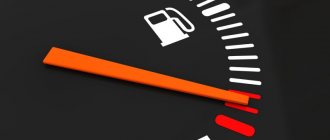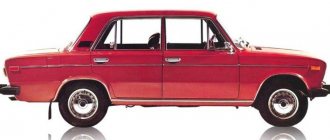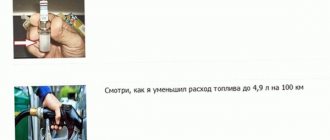The production of the five-door hatchback VAZ-2109 began in 1987, three years after the appearance of the three-door version of the VAZ-2108. These two cars became a completely unique phenomenon for the Soviet automobile industry - first of all, with their front-wheel drive layout, modern design at that time and an improved interior compared to previous Zhiguli models. The VAZ-2109 was more popular because the five-door design was more convenient than the three-door one.
The production of a car of this model continued until 2004 in the Russian Federation and until 2011 in Ukraine - here the VAZ-21093 version was assembled from vehicle kits supplied to the country by AvtoVAZ. Currently, this model is replaced in production by the VAZ-2114 model.
VAZ-2109 1.1 carburetor
The VAZ-21091 model was equipped with a derated carburetor four-cylinder VAZ-21081 engine with a volume of 1.1 liters. It developed a power of 54 hp. and a torque of 79 Nm at 3600 rpm. The engine was paired with a 4-speed manual transmission, but production of this model did not last long - until 1991, since the engine power was clearly not enough.
Gasoline consumption VAZ-2109 1.1 carburetor per 100 km. Reviews
- Yana, Odessa. My husband and I bought a VAZ-2109 with a 1.1 liter engine in 2013. At first we were surprised, we didn’t think there was such an engine, but it turned out that it was the original engine. The car was produced in 1990, but is in good condition and the engine is actually not as weak as it seems - there are four of us in the family plus a trailer - it drives fine. Consumption on the highway is about 5.5 liters, in the city – about 8.5 liters.
- Vladimir, Kozlovsk. The engine is not original - after mine burned out, I had to replace the engine. I couldn’t find a 1.5 liter one from my family, but through friends I managed to get a 1100 cm3 engine. What can I say about the dynamics - there is none at all, acceleration is generally slow, it does not accelerate more than 100 km/h at all. But in operation it is quiet and economical - 8 liters in the city, 5.5-6.0 liters on the highway.
Consumption of VAZ 21099 with carburetor
Initially, the car was equipped with several modifications of gasoline engines of various designs and volumes. The most affordable was the 1.3 engine with 64 horsepower. It, like other versions of the car, was equipped with a five-speed manual transmission with front-wheel drive. The car accelerated to hundreds in 14.5 seconds with a top speed of 140 km/h. With a carburetor fuel supply system, the fuel consumption of this engine was:
- city 9.1 l;
- average 7.7 l;
- on the highway 5.7 liters.
A rotary version of the engine of the same volume with 135 horsepower was offered, but it was supplied to special services and for export. The installation of this power unit improved the dynamics, but at the same time fuel consumption increased:
- in city mode 12.5 l:
- in a mixed cycle 10 l;
- on a free road 7 l.
The most popular was the 1.5 engine with 70 horsepower; it was distinguished by its reliability, accelerating the car to 150 km/h, and to the first hundred in 14 seconds. It is fueled with AI 92 or AI 95 with fuel consumption similar to the less powerful version:
- in traffic 9.1 l;
- on average 7.7 l;
- on the highway 5.5 l.
VAZ-2109 1.3 carburetor
The base engine for the VAZ-2109 was the VAZ-2108 engine. This is an inline four-cylinder carburetor engine with a volume of 1289 cm3 and a power of 64 hp. and with a torque of 94 Nm. Initially, the engine was equipped with a 4-speed manual transmission, but later a more efficient 5-speed gearbox was installed for it. The model with this engine was in production until 1997.
Also produced in a small series was the VAZ-2109-91 model, equipped with a 1309 cm3 rotary piston engine. This engine developed a record 140 hp for that time. and a torque of 186 Nm, but it was too unreliable and whimsical, so production was curtailed in the early 1990s.
Fuel consumption VAZ-2109 1.3 carburetor per 100 km. Reviews
- Dmitry, Pavlodar. Before my “nine” I had a “kopeck”. After that I wanted to buy a foreign car, but for the amount I had, I could only buy a piece of shit that was trashed. I found a car made in 2000, with a 1.3 liter carburetor. What can I say - I started repairing it literally 30 minutes after purchase, because the battery died. On the highway the consumption is about 7 liters, in the city – at least 8.5-9.0 liters.
- Oleg, Novosibirsk. I bought a “nine” from a friend in 2011. She stood in the garage for almost three years, did not leave and did not start. He discounted it at a normal price, I took it for service and the master said that it was in export configuration - that’s why it was preserved in normal condition, even though it was manufactured in 1993. I did the repairs and after that it started working like clockwork. It starts with half a turn, consumption in the city is 7.5 liters, on the highway generally 5.5 liters. They’ve already offered to buy it more than once or twice, but for now I’ll go on my own.
- Mikhail, Khanty-Mansiysk. I bought the car back in 2006 – and it was hard to call it a car. The box was completely destroyed, the engine was generally in the trunk, I’m generally silent about the wiring and everything else. But the body was in excellent condition, only the wings were overcooked. I completely silenced it, gave the engine a major overhaul, and replaced the gearbox with a five-speed gearbox - by the way, a 5-speed manual transmission is completely useless for it, because... It still doesn’t go more than 130 km/h. But for the city it will do - consumption is about 8 liters, on the highway 6.5.
- Denis, Omby. VAZ-2109, engine 1.3 carburetor, 1994 The car was purchased in 2000, in 2005 I took it for myself after the death of my father. Of course, it has undergone a lot of repairs, but overall the car is not bad - it has soul. Gasoline consumption in the city is 10 liters, on the highway 7 liters, but I like to press on the gas - if I drove more calmly, then the consumption would of course be lower.
Other cars: Audi A7 fuel consumption reviews
What determines the cost of a VAZ?
A front-wheel drive sedan is considered a Russian car, which is intended for traveling on Russian highways. Lada models from 2000 to 2007 have an engine capacity of 1.5 liters. Based on driver reviews, we can conclude that the car feels better in the city than off-road.
| Engine | Consumption (highway) | Consumption (city) | Consumption (mixed cycle) |
| 1.1 | — | 7.9 l/100 km | — |
| 1.3 67 hp | — | 7 l/100 km | — |
| 1.5 | 5.7 l/100 km | 8 l/100 km | 7.7 l/100 km |
| 1.6 | 5.7 l/100 km | 9.1 l/100 km | 7.7 l/100 km |
| 1.3 140 hp | 7 l/100 km | 12.5 l/100 km | 10 l/100 km |
Fuel consumption for the VAZ 21099 (carburetor) depends on:
- year of manufacture of the car;
- on the cleanliness of the filters;
- filled with good quality oil;
- on engine volume;
- on the condition of the injectors;
- depending on the type of ride;
- maneuverability;
- from technical characteristics.
Every experienced driver knows that the filter must be changed frequently to function properly.
Getting around the city
The type of driving and all maneuvers around the city result in high fuel consumption. After all, the engine does not work smoothly, often changes speeds, switches, and because of this, LADA gasoline consumption per 100 km exceeds 12 liters.
It is worth noting that if you live in a big city, where you have to stand in traffic jams for a long time in the morning and evening every day, then it is better to turn off the car so that there is no overheating and excessive consumption of gasoline
The fuel consumption of the Lada 21099 on the highway at average air temperature is about 7 liters, this is an economically advantageous fuel consumption. VAZ is a financially convenient car if you monitor its technical condition.
VAZ-2109 1.5 carburetor
In 1988, production of the VAZ-21093 model began, equipped with a VAZ-21083 four-cylinder carburetor engine. This engine developed a power of 68 hp. and at 3400 rpm it achieved a torque of 104 Nm. This model was in production until 2006, until it was completely replaced by versions with injection engines.
For the VAZ-21093, the engine was paired only with a 5-speed gearbox, which made it possible to achieve significant fuel savings, especially when driving outside the city.
Fuel consumption rate VAZ-2109 1.5 carburetor per 100 km
- Alexey, Barnaul. Before my “nine” with a 1.5 engine, I had the same one, but with a 1.3 liter engine. So, in terms of dynamics, the one and a half car is much more interesting, although the difference in power is only a couple of horses, but it turns much more fun. Well, in terms of consumption, the maximum I could get in the city was 10-11 liters in winter, but on the highway you can safely invest 6 liters.
- Ivan, Irkutsk. I took my “nine” in 2009. Why the “nine” - for my budget they decided to take it better than a foreign car that was trashed. She served me for about six years - after that my dear was so tired that she simply refused to ride. Well, this is not surprising, because the car is from 1996, and more than 10 years is a long time for our automobile industry. Although, in principle, the machine is unpretentious, and the average consumption was 8 liters - for a 1.5 liter carburetor this is not so much.
- Vladimir, Krasnoyarsk. The purchase of the VAZ-2109 was due to numerous advice in the style of “it’s better to buy a domestic car than an imported bucket of bolts for the same money.” I don’t know what the condition of the imported bucket is, but the belching of the domestic auto industry after a closer acquaintance (and I completely disassembled it) is terrible. The engine is mounted on one cushion, the whole body is rotten, the seats are different from each other - and that’s not all. The only plus is the consumption of 9 liters in the city.
- Denis, Novosibirsk. I drive a 1997 Nine. One of the last ones to be produced with a carburetor. I bought the car in 2013, with a mileage of almost 200 thousand km. Yes, it needs to be repaired - but this is done simply and without hemorrhoids, and spare parts cost 10 rubles a bucket, unlike foreign cars. Consumption on the highway is 7 liters, in the city from 9 to 11 liters - depending on how you load it.
- Arsen, Arzamas. My first car - I bought it for 90 thousand rubles in 2006. I drove it for 2 years, it started to rust and rot, half of the components fell off, even though the car was 1996. On the plus side, you can easily fill up with 92 gasoline, and consumption in the city is up to 10 liters.
- Anton, St. Petersburg. VAZ-21093, -1996, complete stuffing (wheels, high panel, heated seats, electric windows). At the time of purchase - and this was 2005 - it was cool! Compared to the “six”, the car is much better - the suspension is softer, the gears are longer and you can safely go 120 km/h on the highway. I used A-92 gasoline and drove without problems with a consumption of about 10-11 liters in St. Petersburg.
- Kirill, Barnaul. The first car, I repaired it a lot and for a long time - but this is probably how it should be, so after three years of ownership I began to quickly understand cars. In general, I’m happy with everything, the consumption is on average 8 liters per hundred square meters, and you can even pour A-80 without any problems if you’re really tight on money.
- Alexander, Feodosia. I bought the car from a guy who had it in his garage for 5 years. Despite the fact that the owner treated the car well, this is still a domestic auto industry. The interior is uncomfortable, everything creaks and cracks, the electrics constantly short out, the body probably begins to rot right as the car leaves the workshop. And the consumption is 9-10 liters on this trough, which practically does not move... In general, I drove it for a year and sold it to hell.
Other cars: UAZ 390995 fuel consumption reviews
VAZ-2109 owner reviews
With engine VAZ-2108 1.1 carburetor
- Maxim, Lipetsk. The car is from 1990, still my grandfather’s. Mileage 300 thousand, flight normal. This is what the Soviet automobile industry means, then they made it for centuries. The undeniable advantage of this car is its very strong bumpers, which are practically not deformed in an accident. True, this is the only safety element of my Lada. But somehow I’m not in a particular hurry, and the car itself sets me up for a quiet ride. The engine is injection, 1.1 liters with 55 horsepower - from eight. A peppy and economical motor, reliable and unpretentious in operation. Gasoline consumption is a maximum of 8-9 liters per 100 km. On the highway it comes out to an average of 6 liters.
- Konstantin, Ekaterinoslavl. The car pleases with comfort in the cabin, despite the interior in the spartan style of the 1980s. All controls work. Fuel consumption with the 1.1 engine is 8 liters. I turned on the gas and a characteristic smell appeared in the cabin. Even the installers could not solve the problems. You have to drive with the windows open.
- Denis, Tomsk. I liked the car, it is unpretentious and easy to maintain. Under the hood is a basic 1.1-liter fuel-injected engine that produces 54 horsepower. The maximum speed with it is 150 km/h according to the passport, but in reality a comfortable speed is 120-130 km/h. Fuel consumption is 7-8 liters per 100 km.
With VAZ-2108 1.3 engine carburetor
- Alexey, St. Petersburg. A car for all occasions. I had a three-door VAZ-2108, but then I changed it to a five-door 2109 when I had a family. I didn’t regret one bit that I took it with a more powerful 1.3-liter engine. The 1.1-liter engine in my V8 is peppy and torquey, but compared to the 1.3-liter engine, the difference is obvious, which is why I went with this engine. I often drive at high speeds, as the engine is very economical. In the city it consumes no more than 8-9 liters, and on the highway it consumes only 7 liters. The car is for every day, you just need to check it before each trip, otherwise everything is fine.
- Daniil, Nizhny Novgorod region. I liked the car, just right for me. I am an undemanding person, with a Soviet education. The car is equipped with a 1.3-liter carburetor with a consumption of 9 liters per hundred. The manual transmission works smoothly, no need to search for gears. Can be recommended as a first car.
- Anatoly, Sverdlovsk. I'm completely satisfied with the car, it's the best car, and you can't find an alternative to it for that kind of money on the secondary market. Nine has been thoroughly studied by our specialists, and is cheap to maintain. So I don’t have to go into repairs. Reliable transport, without any show-offs. I sat down and drove off. Under the hood is a 1.3 engine with a consumption of 8 liters per 100 km.
- Oleg, Tolyatti. I took a five-door hatchback, which turned out to be much more convenient than my former three-door VAZ-2108. Of course, the main advantage is an additional pair of doors - passengers do not have to get into the cabin through the front seats. There's limited space in the back, but it's such a class, what can you do. The Nine is suitable for daily trips around the city and on the highway, although after 100 thousand noise, vibration and shaking in the cabin are annoying. In general, you can go if your budget is limited. I'm not complaining, I'm telling it like it is. The car is made according to the principle of being cheap and cheerful. The main thing in the nine is reliability and cheap maintenance. Fuel consumption with a 1.3 carburetor engine is up to 8-9 liters per 100 km.
With VAZ-21083 1.5 engine carburetor
- Igor, St. Petersburg. The car was produced in 2000, I bought it at a car dealership. I remember this day, how my swallow sparkled with its red body in the yard - the car was delivered on time, as promised. VAZ-2109 is a decent car for the money, I have never regretted what I bought. Moreover, with a carburetor 1.5-liter engine. It is very unpretentious and reliable; in extreme cases, you can service it yourself. For this, a reference book from the store is enough. That's what I did. By the way, this is my first car, I passed my license in 1999. The reliability of the five-door hatchback is at the highest level. Fuel consumption is 9 liters in the city.
- Olga, Ekaterinoslavl. This nine requires care and regular inspection. In modern realities, a wheelbarrow has no life. I will never buy such a bucket of bolts again; I gave it away without regret. The car had a 1.5 petrol engine and consumed 9 liters of petrol. They gave me 40k for disposal, I added it and bought a used Polo.
- Ekaterina, Tyumen. A universal car, suitable for the city and country roads. I drive it and don’t complain, the car is made quite well for its price. Consumption is 9-10 liters in the city.
- Mikhail, Taganrog. I liked the nine. I wanted to take a foreign car, but my husband decided to sell the car and gave it to me. So far, no complaints, I service it automatically at the service center. Very cheap, I'm pleasantly surprised. Consumption 9 liters. Under the hood there is a 1.5 carburetor.
- Vladimir, Ulyanovsk. I'm as happy with the car as an elephant, this is my first car. I will never forget her. I recently sold it and exchanged it for a Lada Vesta. Our auto industry is growing and developing, and this can be seen if we compare both models. But by the standards of its age, the Nine was an excellent car, quite competitive. With a 1.5 carburetor engine, consumption is only 8-10 liters in the urban cycle.
- Denis, Dnepropetrovsk. VAZ-2109 is my second car, before it there was a VAZ-2101. Of course, a nine cannot be compared with a penny. This is a completely different level - different dynamics, different finishing materials, etc. In terms of reliability, the cars are approximately equal, the main thing is to service them on time and everything will be fine. Gasoline consumption with a 1.5 carburetor is 9 liters.
With engine VAZ-2111-80 1.5 injector
- Alexander, Krasnoyarsk. The car is 2004, from the last batch. I bought it at a significant discount, practically for nothing. I can say that the car suited me, at least as an ordinary means of transportation from point A to point B. Nothing extra, the workmanship is of course at a low level, but for that kind of money you can forgive a lot. Fuel consumption with an injection 1.5-liter engine is 9-10 liters per hundred kilometers. Overall I am satisfied with the car, if we do not consider it as a competitor to European models. But for its time, the car is very decent, with a masculine design and cheap spare parts.
- Oleg, Zhitomir. I was pleasantly impressed with the VAZ-2109; before it I drove the first Volkswagen Golf. Well, surprise, I liked nine more. It is also cramped, but certainly noticeably more spacious than the German one. And there are full four doors. The car consumes 9 liters with a 1.5 engine.
- Maxim, Petropavlovsk. My grandfather drove the nine, then my father and mother, and now I’m showing up like this. The odometer shows 267 thousand km and is still running. Under the hood there is a 1.5 injector, consumption is 10 liters.
- Alexey, Irkutsk. They gave me a car, I have a 1.5 liter injection version, consumption is 9-10 liters per hundred. You can fill in 92nd gasoline, the car is fine.
- Vladislav, Vladimir region. The car is very comfortable and dynamic for the city, with an impenetrable suspension. Consumes 9 liters per hundred, is equipped with a 1.5-liter engine, which runs on gas for me.
- Yuri, Izhevsk. I liked the car, this is my first car. So there is nothing special to compare with, I can only tell you about the advantages. Nine is already outdated, no doubt about it. But it has an advantage that no modern car has - it has amazing cross-country ability due to its high ground clearance. The car is equipped with an injection-type engine; it consumes an average of 10 liters per hundred. Failures are rare, spare parts are cheap.
With engine VAZ-11183-20 1.6 injector
- Igor, Novosibirsk. The wife and children are happy with the car. A typical urban five-door hatchback, with a top-end 1.6-liter engine. It accelerates smoothly and dynamically, only sometimes noticeable shifts between gears are annoying. This is a design feature of the entire eight-wheel family; I dealt with such cars in my youth. I have my own workshop, I service the nine myself. The car consumes 10-11 liters per hundred. I installed the LPG myself, and now all expenses go mainly only to spare parts.
- Anna, Perm. The Nine is like a nine, a reliable and proven car in every sense. That's why I bought it. All craftsmen and mechanics know it, and the parts are cheap. I need a car purely for work, I drive mainly around the city. Consumption 9-10 liters.
- Marina, Cheboksary. I have a VAZ-2109 with a 1.6-liter injector, which is quite reliable and economical. In the city, with a gearbox, 10 liters of gasoline per hundred are released.
- Nikolay, Donetsk. A car for real handy men, not like all these foreign cars. The Nine was created for the working people, it is a people's car. With a 1.6 injector it consumes 9 liters per 100 km.
- Alexey, Arkhangelsk. I bought a VAZ-2109 in 2003, now there are 156 thousand kilometers on the odometer. There are no serious breakdowns as such, the main thing is that I can cope with them. And the car is unpretentious and reliable. But I’ll honestly admit that I always have a set of pelvis pipes in my trunk. The five-door is equipped with a 1.6-liter injector, which consumes no more than 10 liters per 100 km.
- Victor, Belgorod. I liked the car, for the money it’s quite an excellent vehicle for every day use in the city. With the 1.6 engine (injector) low fuel consumption, in the urban cycle no more than 10 liters per hundred. The mechanics work flawlessly, there are no questions about it.
VAZ-2109 1.5 injector
Since 1998, serial production of the VAZ-21093i model began, equipped with a VAZ-2111-80 injection four-cylinder engine with a power of 74 hp. and with a torque of 118 Nm. Compared to carburetor engines, injection engines not only developed higher power and torque, but also had better elasticity at low speeds and were more economical. These engines were also offered with a 5-speed manual transmission.
Reviews about fuel consumption of VAZ-2109 1.5 injector
- Alexey, Tomsk. I wanted a car since I was 18 years old, but naturally there was simply no money for it. Then the car appeared, but another problem arose - I needed a working car, so that killing would not be a pity and would be inexpensive at the same time. I decided to take the injection “nine” 2002. Her condition was more or less - well, what condition can a ten-year-old VAZ have? In principle, it justified itself - spare parts are inexpensive, you don’t mind killing it, and gasoline consumption is 10 liters per 100 km in the city, an injector after all.
- Alexander, Barnaul. VAZ-21093, 2002, 1.5 injector. Purchased with a mileage of 120 thousand km. Everything that could possibly creak in it creaked, and probably even more. There were a lot of mistakes, everything had to be done constantly, but for the money that I paid, I shouldn’t have expected anything else. But low fuel consumption - up to 8 in the city and up to 7 on the highway, as well as the ease of repair and low cost of spare parts compensate for many shortcomings.
- Kirill, Abakan. I bought a “nine” in 2014. The car was produced in 2003, with a one and a half liter injection engine. I bought it when I was a student - what else did I need? The condition is normal, the owner himself admitted that one wing was broken, but it was made very well. At the same time, the luxury package is another plus. Well, efficiency - in winter the maximum reaches 11 liters, in summer about 9, on the highway it depends on the speed - from 6 to 7 liters.
- Denis, Yekaterinburg. I learned to drive in my father’s service VAZ-2109, with a carburetor. In my second year at university, I managed to save some money and buy my own “nine”, but I bought it with an injector - it’s faster than with a carb, and its consumption is lower. In the city I drove consistently 50-70 km/h, consumption was up to 8.5 liters per 100 km, on the highway - no more than 120 km/h, consumption was accordingly about 7 liters.
- Vasily, Ufa. In general, I have a Toyota Corona, but I drive a VAZ-2109 in my free time. I actually bought it by accident - at a gas station I saw a car with an advertisement on the rear window, talked to the owner and bought it. She was in good condition, the car was well maintained, the engine was tuned for maximum efficiency. Believe it or not, in the city 10 liters is enough for me for 130 km, i.e. consumption is around 6.5-7.0 liters per 100 km.
- Grigory, Sergiev Posad. VAZ-21093i, 2001. When purchasing, the budget was 100 thousand rubles - not much, but true. Naturally, I chose only the domestic auto industry, I didn’t even look at foreign cars. In principle, “nine” is the cheapest and most practical option. Yes, you have to tinker with it, but the spare parts are inexpensive, repairs are also simple and can be done in the garage, and the fuel consumption of 8 liters in the city is quite low and no worse than that of many foreign cars.
- Pavel, Moscow. "Nine" 1999. My faithful student car, in which I honestly drove throughout my studies at the university, transported a bunch of girls and my future wife. What else does a student need - consumption in Moscow is a maximum of 10 liters with traffic jams, comfort is not so great, but it is there, spare parts are cheap and you can easily repair it on your own with your dad and you.
Other cars: Nissan Primera fuel consumption
Overconsumption when equipped with an injector
It is worth noting that when changing the fuel supply system, the excess use of gasoline is not less, but has a number of other reasons. Therefore, the fuel consumption of the VAZ 2109 injector corresponds to these indicators
:
- fuel consumption in the city is 7-8 liters per 100 km
- Gasoline consumption standards for the Lada 2109 on the highway are 5-6 liters per 100 km, at a speed of 90 km/h
- fuel consumption on the highway at a speed of 120 km/h - 8-9 liters per 100 km
Failure in the VAZ control system
Any interruptions in the electronic equipment of the car lead to the fact that the real fuel consumption on the injection VAZ 2109 is growing rapidly. If the temperature, oxygen, or mass air flow sensors do not work correctly, the electronic control unit cannot adequately respond to changes. This provokes a sharp deterioration in the fuel situation.
VAZ-2109 1.6 injector
In 2001, the VAZ-210934-20 model appeared. As a power unit, it uses an injection four-cylinder 8-valve VAZ-11183-20 engine with a volume of 1596 cm3. It produces 81 hp. and a torque of 120 Nm and is combined with a 5-speed manual transmission.
Real reviews about fuel consumption of VAZ-2109 1.6 injector per 100 km
- Evgeniy, Ekaterinburg. I’ll say right away that I bought the car to drive. There is nothing native left in her anymore. The engine is 1.6 liters and that friend rebuilt and rebuilt it for me, it now produces more than 100 horses. Consumption, of course, has also increased - in the city it’s about 14 liters, if you drive calmly it’s about 10 liters. But I like it and do everything at the traffic light.
- Ilya, Samara. After I got my license in 2005, I had exclusively domestic cars for almost 8 years. The latest from our automobile industry is VAZ-210934-20, with a 1.6 liter injection engine. The car was produced in 2001, it has covered 150 thousand in 10 years. After the purchase, the engine, suspension and everything else were overhauled - the rest did not cause problems. I’ll tell you, the car is reliable and unpretentious, if you look after it, and it’s also economical - in the city it’s never been more than 9 liters, on the highway it’s about 5 liters in general.
- Denis, Anzhero-Sudzhensk. I bought a car from my father - he still saved up the money to switch to a foreign car, but I got my own car. Its main feature is the engine, 1600 cubes. Consumption in the city is about 10 liters, well, for any car with such an engine it is almost identical. I drove it for a year and a half and decided that it was expensive to refuel with gasoline - I installed an LPG system. Consumption has increased, but this is also because I stopped saving - now in the city I have a stable 12-13 liters, but given the price of gas, this doesn’t bother me at all.
- Kirill, Barnaul. I don’t care about those who criticize the domestic auto industry. Yes, it may be inferior in quality and reliability to foreign cars, but it is also much cheaper to buy and to operate. And if your arms are straight, then everything will be fine. I bought it with a mileage of 150 thousand - I only replaced the chassis, pump and cooling fan. The timing belt was changed at 175,000 km!!! The 1.6 liter engine performs very well, the brain did not float at all. And also economical - in mixed mode it never produced more than 7.5 liters.
- Timofey, Sergiev Posad. "Nine" with a 1.6 liter injector, 2003. Before it there was a “five” - when I changed, it seemed like I was driving a foreign car. Consumption up to 12 in the city and 7 on the highway, I adjusted everything to suit myself - in general, it didn’t bother me at all for 3 years (although I still did minor repairs). Now I’m thinking of selling and buying a Skoda.
- Vasily, Krasnoozerskoe. VAZ is a VAZ. You always know what to expect from him, you know that even with serious repairs you will be able to support him financially. And it carries its rear just like a foreign car. The downside is the constant noise in the cabin, everything creaks and rattles. Consumption on the highway is about 7.5 liters, in the city 10 liters.
On the VAZ 2109 the carburetor has high fuel consumption reasons
- Yes, there are many reasons why gasoline can be wasted... the air filter, spark plugs, the amount of oil, your driving style, finally))) and just in case, check the entire gasoline line again... you never know.
- Well, maybe I don’t know much about this, but still, maybe you’re sucking air somewhere, and that’s where it’s eating.
- Maybe... the carburetor is sucking air, perhaps in the place where it is attached to the engine, try removing the carburetor, applying sealant and screwing it back on.
- Check if the needle is holding! Maybe you are pouring gasoline in buckets.
- Unscrew the spark plugs and see what they look like; if they are smoked, it means the mixture is rich; in general, you need to do this: adjust the valves, then the carb and ignition.
- My father fiddles with carburetors, no one goes to the salon, everyone goes to him! I talked to him, he said that there are a lot of reasons, everything needs to be looked at consistently! Look at the jets as written above, maybe others have stuck it in so that I can come to them again!) )) Look at the spark plugs for carbon deposits and check the gap! As for the sealant as written above, I personally don’t advise you, what do you think, why are there special pads there?))) It’s just from the bastards, when screeding it turns into a groove in places! Take it apart! into pieces and put it on a flat surface, you will see for yourself the gaps. The problem with air leaks can be easily solved, take new gaskets, a round emery stone of large diameter, so that all the surface on the stone is at once and slowly remove it in a circular motion! When I helped my father, we did this they did! Knowing the secrets of the carburetor mechanic, my personal advice is to find an honest worker through a good friend and talk to them like a human being so they can take a look, but in the salon they will just cheat you, and in general they do everything on the fly! And if you find a good carburetor mechanic, fumbling around, they’ll set you up so that you won’t eat much and you’ll squeeze all the juice out of the car!))) My father set it up so that in the city I eat little, but on the highway I fly as I want and at 100 to 5 liters))) Good luck with your decision Problems!
- Everything in the carb is the same garbage, it eats buckets of gasoline. Today I saw a black lady from the pipe and realized that it was an overflow. I revved it up to 6000 tons, because up to 3000 tons there was no blackness visible. Work plan for the float chamber - setting up the floats.
- My cravings have also dropped lately and are eating up a little more than before. They checked everything everywhere, everything is fine. They say that maybe it’s time to change the rings. (mileage 197,000)











